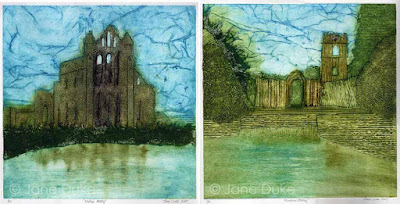 |
| Whitby Abbey and Fountains Abbey each 30 x 30 cm |
And here's a little about how they are made. The first step is to work out the drawings, thinking all the time of how the layers will need to be built up on the plates and the order in which they will be inked up. Once the drawings are finished they have to be traced onto the pieces of mountboard I'm using as plates (remembering of course to reverse the images!).
Then comes the fun bit of building the plates both by cutting away some parts and by adding collage elements. I use different textures of paper, pieces of fabric and pva glue painted on in lines and smears. It's important to remember these are printmaking plates, not collages, so some parts might be counter-intuitive. For instance look at the middle window on the Fountains Abbey tower on the right; I want to 'see' the sky through this, but instead of cutting away a section of the tower which would then just fill with the ink I use for the stonework and be dark (like the small top window), I have stuck on a piece of plain paper which I will be able to wipe clean and then add a little sky colour at the end.
Once the plate is finished it is varnished with several layers of shellac and left for a couple of days to harden completely. Inking up is a long job and has to be carefully planned (you'll notice planning is a recurring theme in printmaking). There's no point adding ink to one area if it's going to be wiped away when you add another. The photo on the left shows the Whitby Abbey plate with the ink laid on the sky, background and pond. I wipe most of this down before adding the ink to the abbey itself, and then there is a lot of wiping, touching up and more wiping. It takes about an hour to reach the stage in the photo on the right, which is the plate ready for printing.
The really magic moment is when you pass a plate through the press and see for the first time what it looks like as a print. There is always an element of surprise - simply the fact the picture is a mirror image of the plate you have been working on for so long means it looks fresh and new.
Then it's time to clean the plate down, prepare another piece of paper and start inking up all over again..... I'm planning to get editions of 15 of each print but collagraph plates are fragile things. Look what started to happen to the Fountains Abbey plate after just three prints.
Aaaagh! This will need careful repair and then more varnishing before I can carry on.
And meanwhile I'm thinking about what will be the next prints in this series. All I can tell you for sure is that they will be abbeys or churches. They might be all in Yorkshire.... or they might not. They might all be ruins... or perhaps not. We'll have to see where inspiration strikes. Do you have any suggestions?






No comments:
Post a Comment
I love to hear people's thoughts on this blog, but there may be a short delay before your comment appears publicly. Thanks for your patience.